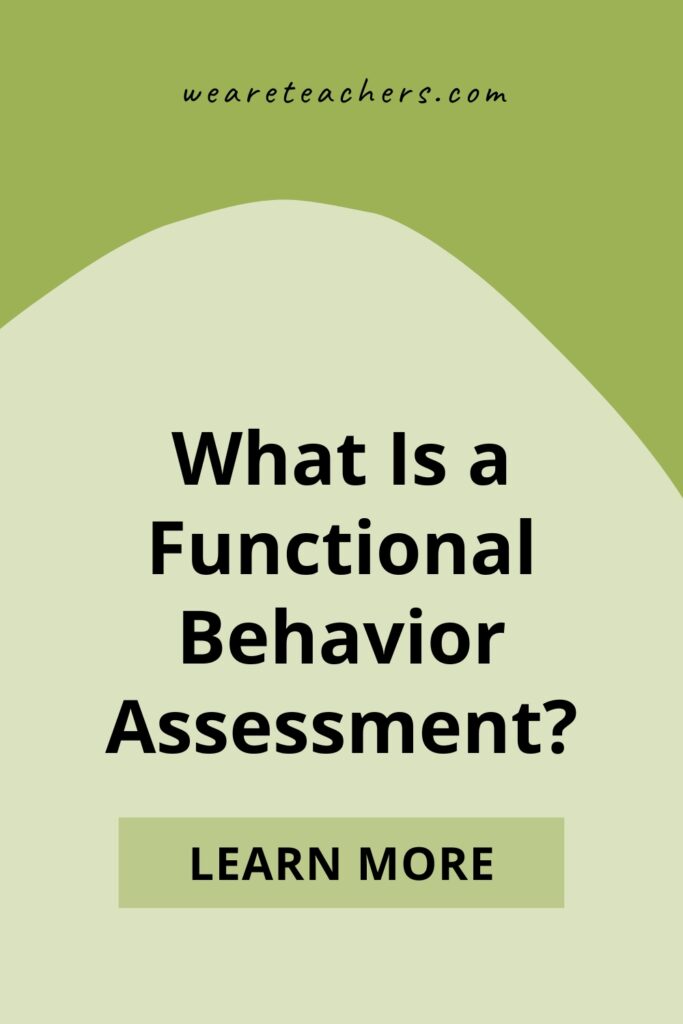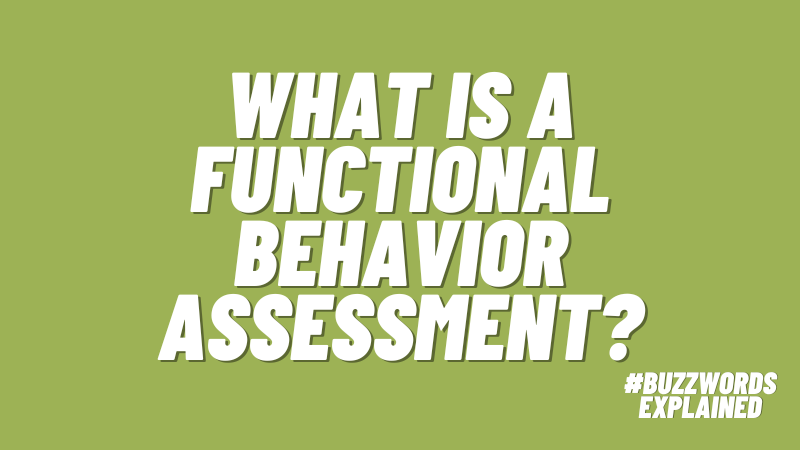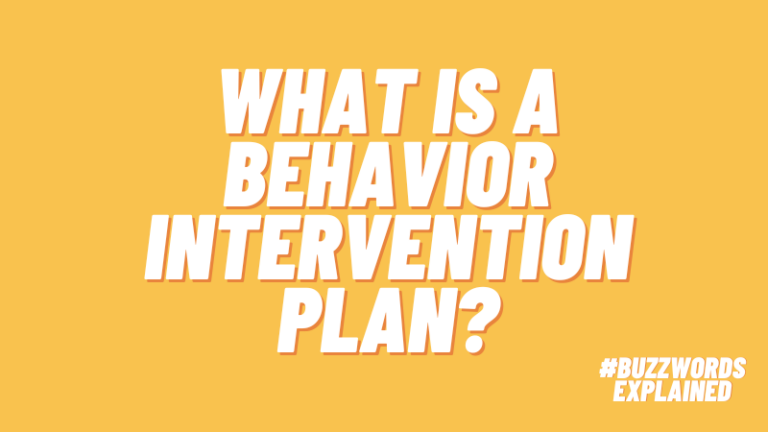If a student is displaying disruptive behaviors, at some point a team of professionals will conduct a Functional Behavior Assessment (FBA). This could be after multiple discipline referrals or suspensions, or it could be as part of a special education evaluation. Whatever the reason, an FBA is an important step in getting to the root cause of why a student is engaging in a specific behavior.
What is a functional behavior assessment?
An FBA is a structured way to collect data about a challenging behavior. It addresses the questions:
- Why does the student demonstrate the behavior?
- What reinforces the behavior?
- What interventions help decrease the challenging behavior and increase a desired behavior?
The idea behind an FBA is that every behavior serves a function—kids get something from the behavior. We all engage in behaviors that serve some purpose for us. Say your principal calls you on the weekend and you dismiss the call. On Monday, the principal doesn’t mention the call. You escaped talking with him and will now be more likely to hang up on him in the future.
In another example, a child sees an ice cream truck coming down the street. They throw a temper tantrum. Their mom buys them ice cream. The connection between the truck, throwing a tantrum, and getting the ice cream (a reward) is clear-cut. After a while, the child may start to scream when they hear the ice cream truck’s music, before it even comes into view.
What is a behavior?
It seems obvious, but defining the behavior you’re focusing on is the first step in an FBA.
A student may demonstrate many behaviors across a school day. For an FBA, focus on the most important (up to five). For example, a child may be getting out of their seat, disrupting class, shouting across the room, and hitting and kicking peers and teachers. But the most important behavior to address would be those that are aggressive—so the team would clearly define the aggressive behaviors and focus on those.
Once you have an idea of the target behaviors, it’s important to define them. So, rather than “aggressive behaviors,” the team may write “hitting, kicking, punching, spitting, motioning to hit.” Without this clarification, someone could classify “spitting” or “motioning” as non-aggressive, even when the team wanted to address those behaviors.
What functions can a behavior have?
There are four functions of a behavior:
- Escape: a behavior serves to help a child escape or avoid something they do not want to do
- Attention: a behavior serves the purpose of getting a child attention from peers or adults
- Tactile: a behavior serves the purpose of getting the child something tangible that they want (this could include food)
- Sensory: a behavior serves the function of meeting a sensory need
Examples:

Source: Pixabay.com
- Escape: Jimmy is presented with a math worksheet. He throws his pencil across the room at a peer. The teacher reprimands Jimmy and tells him to sit in the calm-down corner (he escapes having to complete the worksheet).
- Attention: Jimmy is sitting at his desk. The teacher walks away. Jimmy taps his pencil on the desk. The teacher circles back and tells him to stop tapping. She walks away, he starts tapping again.
- Tactile: The teacher has a bank of Chromebooks. When it’s writing time, some students get to work on the computers. The teacher says it’s time for writing. Jimmy jumps out of his seat and runs across the room, jumping over two desks and knocking over a peer. He grabs a Chromebook.
- Sensory: The teacher turns on the TV to show a video. Jimmy puts his hands over his ears and starts humming loudly.
In each example above, there is an antecedent (Jimmy gets something, the teacher walks away, the video is turned on), a behavior (throwing a pencil, tapping a pencil, running across the room), and the consequence that reinforces the behavior or keeps it going (escaping work, teacher attention, getting a Chromebook, removal of noise from the TV). A teacher, who’s in the moment with Jimmy, and the rest of the students may not notice all the antecedents and consequences with everything else going on, so having an FBA can help focus in on the specific student’s behavior and how it’s serving them.
Read more: What is sensory processing disorder?
Does a student need to have an IEP to get an FBA?
So many acronyms in one question! The short answer is no. Any child who has “target behaviors” or concerning behaviors can have an FBA. Typically, an FBA is conducted when behaviors are impacting a child’s learning or the learning of others. A child may be in MTSS Tier 2 or 3 and the team determines that an FBA is appropriate to help decide what to do next. Or the child may have an IEP and require an FBA for their IEP.
If a child has an IEP, federal law requires an FBA be done whenever a child with a disability has an educational change of placement for disciplinary reasons, including a suspension of more than 10 days, when the child is placed in an alternative school, or if the team determines it necessary. An IEP team may also conduct an FBA if behavior challenges are preventing a child from learning and making progress on their goals.
FBAs are often considered during manifestation determination meetings.
What does the data collection in an FBA look like?
A functional behavior assessment consists of the following steps:
- Agree on the behaviors that need to change and clearly identify them
- Determine where the behaviors occur (and do not occur)
- Collect data. Data could be interviews, observations, questionnaires, a review of previous data, behavior incident reports, and other data. It’s important to collect data from as many sources as possible to get a good understanding of the context and other factors.
Some questions to consider:
- Do the behaviors occur in a specific setting or across the school day?
- What is different about the locations where the behavior does and does not occur?
- What environmental factors influence the behavior (number of peers in the room, staff involved, specific class, etc.)?
- Does the time of day or child’s mood impact the behavior?
- What specific events support or impact the problem behaviors?
From a review of the data, the team will develop ideas around:
- The function of the behavior or what purpose it serves for the child
- Behaviors that can be taught to provide positive alternatives, or replacement behaviors.
Types of data that can go into a functional behavior assessment:
Data for an FBA should capture the student’s experience across the school day. It may include:
- Interviews of parents and teachers who are familiar with the behaviors
- Records review: a review of the child’s record to identify behavior concerns and patterns
- Observations: observations of the child across multiple settings that includes ABC data collection
What is ABC data?
An important type of data in an FBA is ABC data. ABC data collects Antecedent, Behavior, and Consequence data. This can be through questionnaires or observations. With this information, the team can analyze exactly what’s happening right before and after a behavior to form a hypothesis about the function of the behavior and why it’s maintained in that environment.
Who can do a functional behavior assessment?
Many different people can perform an FBA; anyone trained in FBA data collection and analysis can conduct the interviews and observations. This person could be a school psychologist, special education teacher, behavior analyst, or school administrator.
What happens after an FBA?
After an FBA, a Behavior Intervention Plan (BIP) will be put in place with strategies that the team can use to:
- Modify the curriculum, environment, activities, or interactions to prevent the behavior
- Teach replacement behaviors that serve the same function and can replace the problem behaviors
Functional behavior assessment is not …
It may be a relief to hear that an FBA is being completed, but an FBA is an analysis of the behavior, not a “magic bullet.” An FBA won’t stop the behavior and it may raise more questions than answers. An FBA is also not a behavior intervention or a behavior plan.
Additional Resources
Here is a helpful printable for parents from the PACER Center.
The Center on Positive Behavioral Interventions & Supports has resources on FBAs and BIPs.
Basic FBA to BIP has resources for completing FBAs.
The Iris Center at Vanderbilt University has a module on FBAs and BIPs.
Do you have more questions about functional behavior assessment? Connect with other teachers in the WeAreTeachers HELPLINE on Facebook.
For more practical articles for teachers, be sure to subscribe to our newsletters.


